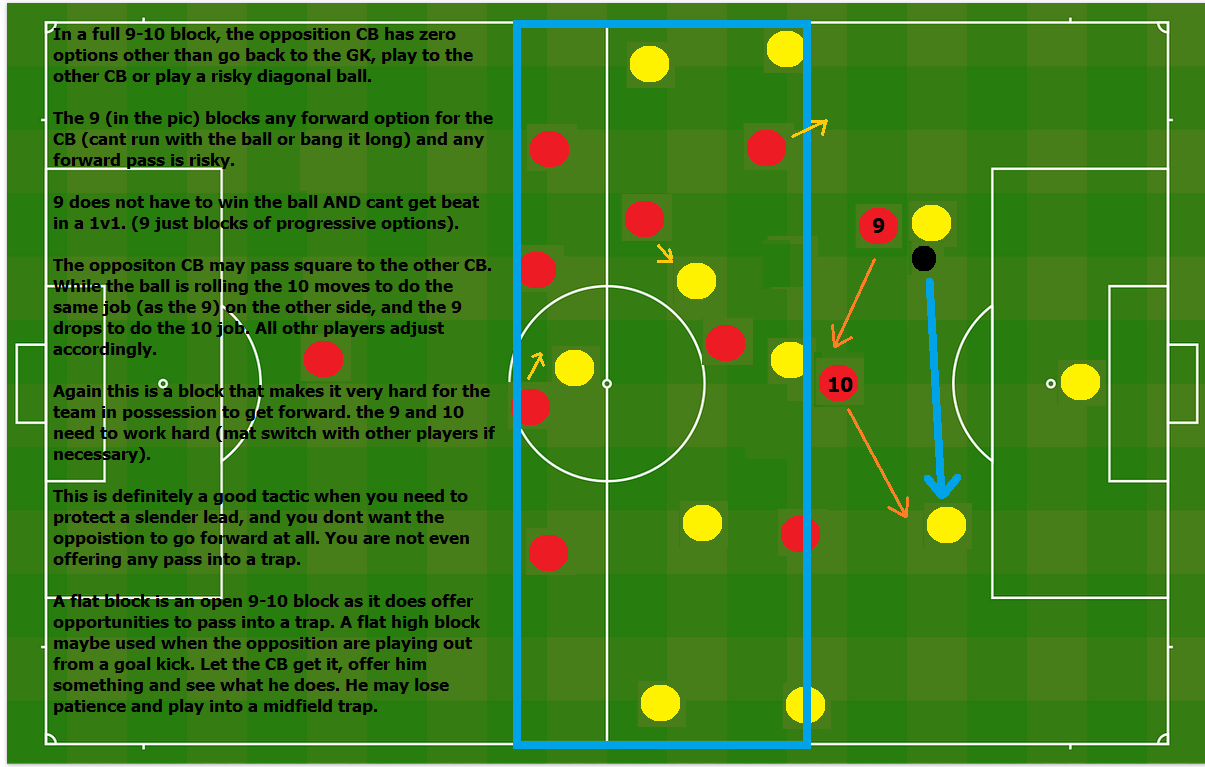An example of Team Specific Instructions
The whole team Working as a Defensive Unit :
[A 9-10 mid block for example].
- Keeper - plays as a sweeper anticipating balls over the top. Defenders are also very mindful of when they need to drop early. There 2 main moments when defenders should drop :
- When an opposition player has the ball in their half and has time to look forward, and hit a pass over the top.
- When a opposition breaks the midfield line and attacks the defensive line.
- Strong defensive line makes sure the spaces between the lines are not too big, but always moves together, drops when necessary, and covers each other (as a defender may need to press in the midfield space) and fills gaps when necessary.
- There is constant talking.
- 6 and 8 : Provides cover in front of the defensive line and mostly presses hard from lower positions when ball enters the midfield space
- 9 and 10 and at least 1 winger : Presses hard from high positions (Initially) when ball enters the midfield space. The aim of this press : Opposition midfielders never get time and space.
- Wingers either help their FB by either pressing in wide areas on their side, or by supporting the midfield by tucking in to become a wide midfielder on the non-ball side (to prevent an aggressive switch. if the opposition do switch then they need to use their FB and this slows the switch down).
Working as a Unit in a #9-#10 mid block
Blocks are looked at in more details on the next few pages.
All players are part of the defensive unit when not in possession and
getting all these moments right is critical to good defending.
- The nearest 2 or 3 players put pressure on the ball and cut of dangerous passing lines as soon as the ball is lost, to stop a quick forward pass (stop a counter attack).
- All other players quickly for a block and set a trap.
- The defensive line drops early if a ball over the top is imminent (and goal keeper gets ready to sweep if necessary).
- If the defensive lines gets stretched or pulled out of shape, players look to covering and fill spaces.
- Defenders and midfielders need to ensure they do not over shuffle towards the ball when the opposition have it in wide areas ( Over shuffling will leave the area in front of the goal poorly defended. The opposition cant score from wide positions so sometimes winning the ball out wide is not as a important as defending the key goal scoring space ).
- Defending the key goal scoring spaces when necessary (crosses, corners, free kicks) is critical. This requires 3 players minimum, and includes the necessity to attack the ball when it comes in. Don't ball watch. Shape is only the starting position. Good shape in itself is never enough.
- Always communicating what you can see This applies mostly to players who can see the game the best. Be the eyes for players who can't see what you can see. So non-ball side full backs who can see the whole game should be the most vocal.
Task :
Watch the video above and find moments from the video when the key defending fundamentals were applied at the highest level of the game.
